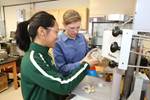Plastics Technical Conference Returns to Penn State Behrend
Returning last June after a pandemic hiatus, Penn State Behrend (Erie, Penn.) will once again host its Innovation and Emerging Plastics Technologies Conference.
Held annually on the Penn State Behrend campus in Erie, Penn., the Innovation and Emerging Plastics Technologies Conference will return this month (June 21-22; Burke Center). Over two days, attendees will have the chance to attend keynote addresses each morning, following that, the conference includes half-hour presentations in the mornings, with three concurrent sessions on injection molding technology, materials technology and executive/management practices. The afternoon programs feature a choice of three-hour tutorials, with many including a hands-on component provided in the university’s 10,500-ft2 plastics processing lab. Networking events will take place after the tutorials.
The keynote speaker will be Timothy W. Simpson, the Paul Morrow Professor of Engineering Design and Manufacturing and co-director of Penn State CIMP-3D at Penn State University. Simpson will discuss Innovating on the Digital Frontier: Making Sense of Industry 4.0 and Digital Connectivity on Wednesday, June 22.
On Thursday, June 23, Alicyn Rhoades, vice chancellor and associate dean for research and graduate studies and associate professor of engineering at Penn State Behrend, will kick off that day’s talks with an overview of current research at Behrend and new initiatives.
Session speakers include thought leaders from injection molding machine suppliers, auxiliary equipment manufacturers, resin makers, additive manufacturing technology companies and more. Tutorial topics include laser marking and welding plastics; low pressure molding; diagnosing warpage; injection molding setup and control; polymer rheology; and additive manufacturing among others.

Penn State Behrend’s Innovation and Emerging Plastics Technologies Conference (June 21-22; Erie, Penn.) includes technical sessions, as well as tutorials in its plastics processing lab.
Photo Credit: Penn State Behrend
Related Content
-
Process Monitoring or Production Monitoring—Why Not Both?
Molders looking to both monitor an injection molding process effectively and manage production can definitely do both with tools available today, but the question is how best to tackle these twin challenges.
-
How to Reduce Sinks in Injection Molding
Modifications to the common core pin can be a simple solution, but don’t expect all resins to behave the same. Gas assist is also worth a try.
-
A Systematic Approach to Process Development
The path to a no-baby-sitting injection molding process is paved with data and can be found by following certain steps.












